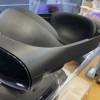Leaked benchmarks show Intel is dropping hyperthreading from i7 chips

While Intel's naming scheme for its processors is often best described as "obtuse," there have been some patterns that the company seemed to follow. For desktop processors, the i7 branding denotes chips with hyperthreading enabled, running two threads on each core. i5-branded parts had the same number of cores but with hyperthreading disabled. i3 parts in turn had fewer cores than i5 parts, but once again with hyperthreading enabled. The 8th generation chips changed this pattern a little—the desktop i3s don't have hyperthreading, just fewer cores—but the relationship between the i5s and i7s remained.
It looks like the next batch of Intel processors, probably branded 9th generation, is going to shake this situation up further. Benchmarks found in the SiSoft Sandra database list a Core i7-9700K processor. This increases the core count from the current six cores in the 8th generation Coffee Lake parts to eight cores, but, even though it's an i7 chip, it doesn't appear to have hyperthreading available. Its base clock speed is 3.6GHz, peak turbo is 4.9GHz, and it has 12MB cache. The price is expected to be around the same $350 level as the current top-end i7s.
For the chip that will sit above the i7-9700K in the product lineup, Intel is extending the use of its i9 branding, initially reserved for the X-series High-End Desktop Platform. The i9-9900K will be an eight-core, 16-thread processor. This bumps the cache up to 16MB and the peak turbo up to 5GHz—and the price up to an expected $450.









































































